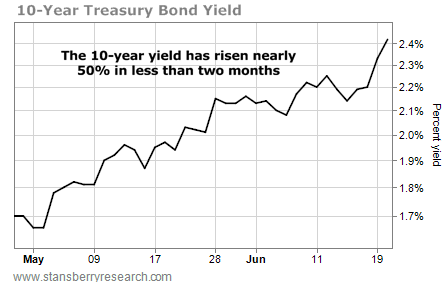The crisis is OVER for big banks...
During the 2008-2009 credit crisis, financials were one of the worst-hit sectors. Without cash injections from our government, several big companies in this sector may have fallen into bankruptcy. That includes heavyweights like Citigroup and Bank of America.
But things are looking much better these days. And bank stocks are setting up to be huge winners over the next 12 months.
In the first few years following the crisis, banks faced huge headwinds. The housing market was still depressed. In short, there were tons of foreclosures (bad assets) on the balance sheet of banks. These homes couldn't be sold at market prices.
Plus, heavy regulation was on the way. Most new rules proposed by our government were designed to shrink banks – which in turn would lower profits.
Under these conditions, it did not make much sense to own banks.
However, many of these conditions have now reversed. And many banking stocks – despite their quick move higher over the past few months – stand to benefit greatly both in the short and long term.
Let me explain...
Over the past two months, interest rates have been on a tear. The 10-year Treasury bond yield is up 49%. And mortgage rates have jumped from 3.4% to 4% (an 18% increase) in the same time frame. These are both 15-month highs. And for interest rates... those are major moves in such a short period.

Rising interest rates are widely viewed as a negative for stocks. Borrowing costs for consumers and businesses are moving higher. Plus, higher interest rates could persuade investors to move their money out of stocks and into interest-paying alternatives.
But higher interest rates are great for bank stocks. That's because the spread between the cost to borrow money and the actual rates banks can charge their customers widens.
You see, banks have plenty of cheap money at their disposal. (The average interest rate on a savings account, for example, is about 0.44% right now.) But with interest rates on long-term debt rising, banks can lend that money back out at much higher rates – in a mortgage at 4%, for example.
The higher those rates go, the wider the spread gets... and the bigger the banks' profits.
Last week, JPMorgan CEO Jamie Dimon explained that if interest rates climbed 300 basis points (3%), his bank would make an extra $5 billion in profits.
And rising interest rates are not the only reason to own bank stocks...
Today, home prices are rising at their fastest pace in seven years. Keep in mind, many large banks wrote down billions of dollars in mortgages in the past few years. Now that the housing market is rebounding, some of these foreclosed homes can now be sold. If the housing market continues to rebound – which most experts predict – this will result in huge profits for banks going forward.
Also, banks have done a great job adapting to new regulations. Sure, new capital requirements have resulted in lower profits. But almost every management team in the banking industry has updated investors about their progress on these new rules in each passing quarter. Now that most have been implemented, this risk seems largely priced in to bank stocks here.
To play this banking trend, you can buy individual names like Bank of America (huge leverage to housing) or JPMorgan (major beneficiary of rising interest rates). Based on the catalysts mentioned above, I'm confident these two names will easily outperform the market in the short and long term.
Another good way to play this trend is to buy the Financial Select Sector SPDR Fund (XLF). Its top holdings include some of the biggest banks in North America. The yield on XLF is 1.6%, lower than the average S&P 500 company. But I expect earnings to grow at least three times faster over the next 12 months. That makes XLF, trading at 11 times earnings, dirt-cheap.
I suggest adding some financial exposure to your portfolio right away.
Good investing,
Frank Curzio
No comments:
Post a Comment